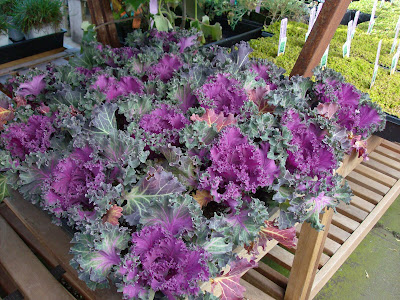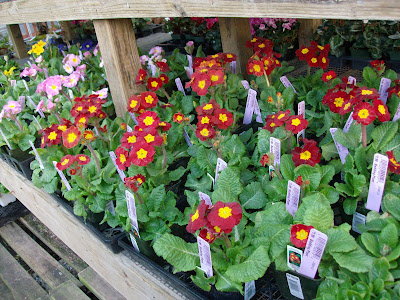Wednesday, January 27, 2010
Tuesday, January 26, 2010
Monday, January 25, 2010
Starting Seed Indoors
Starting Seed Indoors
Several critical factors to remember when starting seed indoors:
LIGHT: A window or normal household light is not adequate light for starting seedlings indoors. Fluorescent tubes work the best. Use at least a double tube setup with one tube being a cool-white and one tube being a warm-white. Tubes should be no more than 3" away from the seedlings. Seedlings should receive 16 hours of light (a dark period is important, so don't leave lights on for 24 hours...use an automatic timer).
MOISTURE: Seedlings must be kept moist (not soggy) at all times.
TEMPERATURE: For most varieties, normal household temperature (70 - 80 degrees) is ideal for germination; 60 - 70 degrees will work just fine. A 10 degree drop in temperature at night is also preferable.
SOIL: Your local independent garden center will carry special sterilized soils for seed starting.
HARDENING OFF: When your plants are ready to go outside, start slowly! Put them outside for a few hours everyday; slowly increase the time outdoors daily. In a week to ten days, they will be ready for outdoors.
© 2004 Botanical Interests
(We carry Botanical Interests seeds at all Sloat Garden Center locations)
Several critical factors to remember when starting seed indoors:
LIGHT: A window or normal household light is not adequate light for starting seedlings indoors. Fluorescent tubes work the best. Use at least a double tube setup with one tube being a cool-white and one tube being a warm-white. Tubes should be no more than 3" away from the seedlings. Seedlings should receive 16 hours of light (a dark period is important, so don't leave lights on for 24 hours...use an automatic timer).
MOISTURE: Seedlings must be kept moist (not soggy) at all times.
TEMPERATURE: For most varieties, normal household temperature (70 - 80 degrees) is ideal for germination; 60 - 70 degrees will work just fine. A 10 degree drop in temperature at night is also preferable.
SOIL: Your local independent garden center will carry special sterilized soils for seed starting.
HARDENING OFF: When your plants are ready to go outside, start slowly! Put them outside for a few hours everyday; slowly increase the time outdoors daily. In a week to ten days, they will be ready for outdoors.
© 2004 Botanical Interests
(We carry Botanical Interests seeds at all Sloat Garden Center locations)
Wednesday, January 20, 2010
Tuesday, January 19, 2010
It's Meyer Lemon season!
Monday, January 18, 2010
Thursday, January 14, 2010
New at our Sloat Blvd location!
This just in from our Sloat Blvd location
We have lots of dahlias and gladiolas, perennial bulbs like hostas, canna, crocosmia and amaryllis belladonna, rhubarb and asparagus, onion sets and of course, lily of the valley.
Lots of other unique stuff, too! Stop by!
We have lots of dahlias and gladiolas, perennial bulbs like hostas, canna, crocosmia and amaryllis belladonna, rhubarb and asparagus, onion sets and of course, lily of the valley.
Lots of other unique stuff, too! Stop by!
Monday, January 11, 2010
Time for a list! Our Top 10 favorite gardening products & tools for 2010

We asked our staff what gardening tools they’ll be using in the new year and here are their responses!
1. Fish Emulsion – Can you say LOVE? Our staff uses Fish Emulsion on everything in the garden. This easy to use and fast acting organic plant food with kelp helps plants grow, flower, fruit and stay deep green. We swear by it!
2. Fox Farm Fertilizers - Over the last 12 months we’ve received rave reviews from customers about Fox Farm fertilizers… But our staff and mangers love them, too! Ideal for all flowering and fruiting plants and easy to use!
3. Micro Bark – We really like the neat and tidy look of Micro Bark and also, its effectiveness with inhibiting weed growth and soil moisture conservation. Ideal for walkways, gardens and play areas; it also protects roots from summer heat or winter cold.
4. Sloat Loam Builder – Really, we’re not just patting ourselves on the back here… This rich amendment makes any garden thrive – ornamentals and edibles do exceptionally well when Sloat Loam Builder is used.
5. Maybe it goes without saying – but we swear by E.B. Stone’s Sure Start! We don’t plant anything without this planting-time fertilizer. It’s made from a blend of organic ingredients formulated to help newly transplanted plants develop strong roots and sturdy growth.
6. Can-O-Worms Worm Composter – Talk about fun for kids…and eco-friendly too! This is an odorless, user-friendly worm composting system that allows anyone to participate in recycling and gardening via composting. Wow…love, love, love this product!
7. Bahco Pruning Snips are incredibly lightweight yet have strong blades. They can cut a wide variety of plants, from long flowers to pruning roses. Also great for small jobs, deadheading, tight spots and bonsai. These are terrific general use pruners!
8. Serenade Disease Control - provides protection against the most common fungal and bacterial garden diseases, yet is non-toxic to bees and beneficial insects. Safe to use around kids and pets. We really recommend this product!
9. West County Gardener Gloves – quality glove for every type of gardening job.
10. Earthbox – Right in the middle of the grow-your-own food craze comes the Earthbox planter. This maintenance-free growing system controls soil conditions, eliminates guesswork and more than doubles your garden’s yield. Wow. Earth boxes have been extremely popular in all our stores.
ok...we said 10, but here's one more for good luck!
11. Keeper Stoppers - keeps soil in and insects out of pots. We use these religiously and cannot recommend them enough!
p.s. We'll unveil favorite plants for 2010 as spring approaches!
Wednesday, January 6, 2010
Compost Your Coffee Grounds!
Excerpted from the Gardener's Supply Company
By Kathy LaLiberte
When I go to my local coffee shop, I often come out with more than a cup of coffee. Near the door, they have a bin with free bags of used coffee grounds. Like most avid gardeners, I find it impossible to resist free food for my garden!
In the spring, I spread handfuls of coffee grounds around my acid-loving plants—azaleas, blueberries, rhododendrons. The grounds are slightly acidic and besides helping to lower the soil pH, they foster the humus-rich soil texture these plants really love.
In late summer and fall, I dig coffee grounds right into the vegetable garden after removing early-season crops such as peas and spinach. In the winter, I add the grounds to my compost pile. They’re a good source of nitrogen at a time of year when that can be a little difficult to come by.
Efficient composting depends upon a well-balanced mix of ingredients, which generally fall into two categories: browns (high carbon), and greens (high nitrogen). The list at right gives examples of both types of ingredients. The ideal ratio is 25:1 (brown to green) but most people find three parts brown and one part green works quite well. Remember to layer your ingredients, keep the pile moist (like a well-wrung sponge) and turn it occasionally to incorporate a fresh supply of oxygen for the microbes.
* Master Composter, a website for composting enthusiasts, conducted a Coffee Grounds Survey on the use of grounds—in compost and in the garden.
* If you're looking for a source of grounds, try Starbucks Coffee and Peet's Coffee. Both companies have researched the issue further and share the results on their web sites.
By Kathy LaLiberte
When I go to my local coffee shop, I often come out with more than a cup of coffee. Near the door, they have a bin with free bags of used coffee grounds. Like most avid gardeners, I find it impossible to resist free food for my garden!
In the spring, I spread handfuls of coffee grounds around my acid-loving plants—azaleas, blueberries, rhododendrons. The grounds are slightly acidic and besides helping to lower the soil pH, they foster the humus-rich soil texture these plants really love.
In late summer and fall, I dig coffee grounds right into the vegetable garden after removing early-season crops such as peas and spinach. In the winter, I add the grounds to my compost pile. They’re a good source of nitrogen at a time of year when that can be a little difficult to come by.
Efficient composting depends upon a well-balanced mix of ingredients, which generally fall into two categories: browns (high carbon), and greens (high nitrogen). The list at right gives examples of both types of ingredients. The ideal ratio is 25:1 (brown to green) but most people find three parts brown and one part green works quite well. Remember to layer your ingredients, keep the pile moist (like a well-wrung sponge) and turn it occasionally to incorporate a fresh supply of oxygen for the microbes.
* Master Composter, a website for composting enthusiasts, conducted a Coffee Grounds Survey on the use of grounds—in compost and in the garden.
* If you're looking for a source of grounds, try Starbucks Coffee and Peet's Coffee. Both companies have researched the issue further and share the results on their web sites.
Tuesday, January 5, 2010
2010
for
last year's
words
belong
to last year's
language.
and
next year's
words await
another
voice.
and
to make an
end is to
make a
beginning
-T.S. Eliot
last year's
words
belong
to last year's
language.
and
next year's
words await
another
voice.
and
to make an
end is to
make a
beginning
-T.S. Eliot
Subscribe to:
Comments (Atom)












